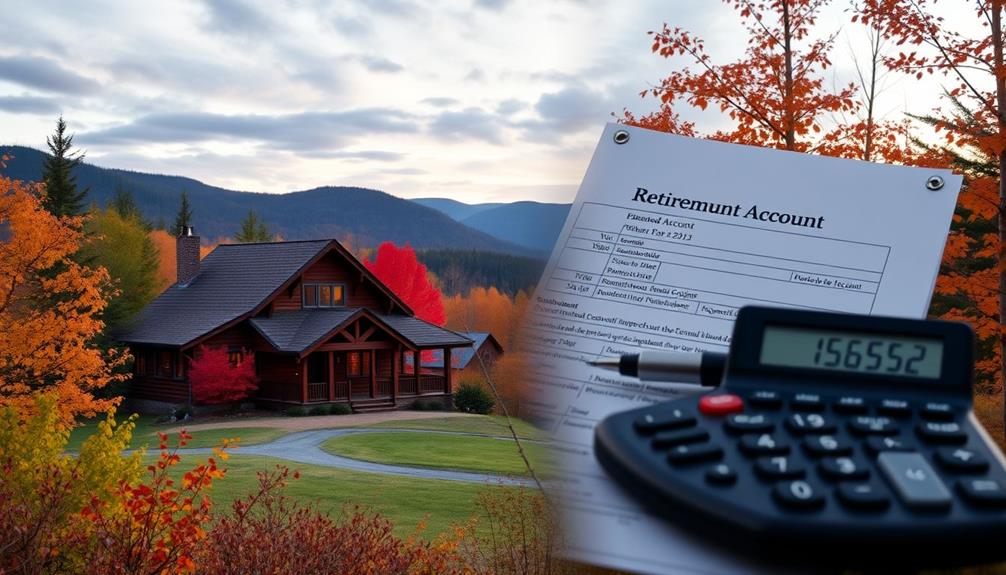Integrating IRAs with Vermont’s state-specific benefits can significantly increase your retirement savings. Start by considering a Traditional or Roth IRA alongside programs like VTSaves, which automatically enrolls you and allows for pre-tax contributions. State retirement systems, such as VMERS and VSRS, offer defined benefit plans that complement your IRAs. Be aware of tax implications, particularly on withdrawals and Required Minimum Distributions. Understanding these factors improves your overall financial strategy, providing a clearer path to retirement. There is a wealth of information available to further guide your decisions and assist you in planning wisely.
Key Takeaways
- Combine contributions to Traditional or Roth IRAs with state retirement systems like VSRS and VMERS for a comprehensive retirement strategy.
- Utilize the VTSaves auto-IRA program to maximize pre-tax contributions and enhance overall retirement savings alongside state benefits.
- Understand the tax implications of withdrawals from IRAs and state retirement plans to optimize retirement income and minimize tax liabilities.
- Take advantage of educational resources and financial planning seminars offered by Vermont's retirement systems to inform your retirement strategy.
- Regularly review and adjust contribution rates to VTSaves and other plans to align with retirement goals and financial circumstances.
Understanding Retirement Planning in Vermont

When you think about retirement planning in Vermont, it's important to understand the resources available to you. If you're a state employee, the Vermont State Employees Retirement System (VSRS) offers a defined benefit plan that's based on your service credit, age at retirement, and average final compensation.
After five years of creditable service, you become vested, ensuring you'll retain your benefits when you meet the eligibility criteria.
For municipal employees, the Vermont Municipal Employees Retirement System (VMERS) provides similar benefits with actuarial reserved plans and varying contribution rates. These systems are designed to provide a safety net for state and municipal workers as they plan for retirement.
If you're in the private sector, you can take advantage of VTSaves, a state-mandated retirement savings program. It's particularly beneficial for low to moderate-income earners, allowing you to contribute through payroll deductions.
The default contribution rate starts at 5%, but it can increase annually, giving you the chance to boost your retirement savings considerably. Understanding these systems will empower you to make informed decisions as you approach retirement in Vermont.
Overview of IRAs and Their Benefits

When planning for retirement, understanding Individual Retirement Accounts (IRAs) is essential.
You can choose between Traditional and Roth IRAs, each offering unique tax advantages and contribution limits.
Knowing how these accounts work can help you maximize your savings and tailor your retirement strategy effectively.
Types of IRAs
Understanding the different types of Individual Retirement Accounts (IRAs) can greatly enhance your retirement savings strategy. The two main types are Traditional IRAs and Roth IRAs, each with distinct benefits that suit various financial situations.
| Type of IRA | Key Features |
|---|---|
| Traditional IRA | – Contributions may be tax-deductible |
| – Taxes are paid upon withdrawal | |
| – Ideal for those expecting a lower tax rate in retirement | |
| Roth IRA | – Contributions made with after-tax dollars |
| – Withdrawals are tax-free in retirement | |
| – Beneficial for those expecting a higher tax rate in retirement |
In 2023, you can contribute up to $6,500 if you're under 50 and $7,500 if you're 50 or older, allowing you to catch up on retirement savings. You can open IRAs at various financial institutions, giving you the flexibility to choose from numerous investment options, including stocks, bonds, and mutual funds. Plus, you can make contributions until the tax filing deadline, maximizing your retirement savings potential.
Tax Advantages Explained
How can IRAs enhance your retirement savings strategy? Individual Retirement Accounts (IRAs) offer significant tax advantages that can help you build a more secure financial future.
With traditional IRAs, your contributions may be tax-deductible, lowering your taxable income for the year. This means you can enjoy immediate tax relief while your investments grow tax-deferred until you withdraw them in retirement.
On the other hand, Roth IRAs allow for tax-free withdrawals, making them an attractive option if you expect to be in a higher tax bracket when you retire.
In Vermont, state-sponsored retirement options like the VTSaves program can further boost your savings. Through this initiative, employers can facilitate employee contributions via payroll deductions, simplifying the saving process.
Plus, with the annual increase in contribution limits—$6,500 for most individuals and $7,500 for those aged 50 and over—you can maximize your retirement savings potential.
Contribution Limits Overview
IRAs provide a structured way to enhance your retirement savings, and knowing the contribution limits is essential for maximizing their benefits. For 2023, the IRS sets the contribution limit at $6,500 for individuals under 50, while those aged 50 and over can contribute up to $7,500, thanks to catch-up contributions. This flexibility allows you to adjust your contribution rate based on your retirement goals.
If you're considering a traditional IRA, keep in mind that contributions may be tax-deductible, depending on your income and participation in employer-sponsored retirement programs. This can greatly lower your taxable income.
On the other hand, Roth IRAs offer the benefit of tax-free withdrawals in retirement, provided you've held the account for at least five years and are at least 59½ years old.
You can contribute to both types of IRAs in the same year, but your total contributions mustn't exceed the annual limit.
For Vermont residents, integrating your IRA contributions with state-sponsored retirement plans, like VTSaves, can further enhance your savings strategy, aligning well with the Vermont State Employees Retirement system.
Vermont State Retirement Systems Overview

In Vermont, understanding the state retirement systems is essential for your planning.
The Vermont State Retirement System (VSRS) offers a defined benefit structure based on your service and compensation, while the VTSaves program provides additional savings options.
You'll also find various contribution plans tailored to different employment groups, ensuring you can choose what's best for your future.
VSRS Benefits Structure
For those considering retirement in Vermont, understanding the Vermont State Retirement System (VSRS) is vital. This defined benefit plan provides retirement benefits based on your service credit, retirement age, and average final compensation, offering a predictable income during retirement.
Once you accumulate five years of creditable state service, you become vested, which means you can retain your pension benefits even if you leave your state job.
The VSRS calculates your retirement benefit using a formula that considers your years of service, your age at retirement, and your average final compensation over a particular period. This tailored approach guarantees that your benefits reflect your individual work history and contributions.
Moreover, the VSRS includes various eligibility groups, such as Group A for original plan members, Group C for law enforcement officers, and Group G for specific Department of Corrections employees. Each group has distinct benefits and requirements, so it's important to know where you fit in.
Regular updates on benefit calculations and retirement planning resources are available, helping you make informed decisions about your financial future. Understanding the VSRS benefits structure is a key step in your retirement planning journey.
VTSaves Program Details
VTSaves is a game-changer for retirement savings in Vermont, providing a state-sponsored auto-IRA program designed to enhance access for private-sector employees, especially those in low to moderate-income brackets.
Launched in June 2023, this initiative requires employers with five or more employees to offer VTSaves or a comparable retirement plan. Depending on your company's size, specific enrollment deadlines apply—July 1, 2025, for businesses with 25+ employees and July 1, 2026, for those with 5-14 employees.
The program sets a default contribution rate of 5% of employee salaries, increasing by 1% annually until reaching a maximum of 8%. As an employee, you have the flexibility to adjust your contributions anywhere from 1% to 100%. Contributions to VTSaves are made through payroll deductions on a pre-tax basis, which helps lower your taxable income while encouraging consistent retirement savings.
To guarantee compliance and transparency, VTSaves follows federal regulations and undergoes regular audits.
As a participant, you'll receive annual statements detailing your account performance, making it easier to track your retirement progress.
Contribution Plan Options
With retirement savings options expanding in Vermont, understanding the state's retirement systems is essential for making informed choices. Vermont offers a mix of defined benefit plans, such as the Vermont State Retirement System (VSRS) and the Vermont Municipal Employees Retirement System (VMERS), both designed to provide reliable retirement benefits based on service credit, age at retirement, and average final compensation.
The VSRS features several eligibility groups, with distinct contribution rates tailored to each. For example, Group A applies to original state employees, while Group C targets law enforcement officers.
VMERS requires mandatory enrollment for municipal employees working over 24 hours a week and school district employees working over 30 hours a week, with variable contributions based on membership group.
Additionally, Vermont provides a defined contribution plan for exempt employees, offering an alternative to the traditional defined benefit structures. Your retirement benefits from this plan depend on account performance and contributions made through payroll deductions.
Key Features of VMERS

The Vermont Municipal Employees Retirement System (VMERS) offers essential benefits for eligible municipal and school district employees, ensuring financial security in retirement. This defined benefit plan is actuarial reserved and joint-contributory, providing a reliable source of retirement income.
Membership is mandatory for school district employees working 30 or more hours per week, and municipal employees working 24 or more hours per week. You'll vest after five years of creditable service, securing your future pension benefits even if you leave active membership.
Contribution rates differ by group, with Group A members contributing 3.250% and Group D members contributing 12.100%. Employers also contribute varying amounts, enhancing your overall retirement benefits.
Normal retirement eligibility depends on your group; Group A members qualify at age 65 with five years of service, while Group C/D members become eligible at age 55 with the same service requirement.
If you're part of state law enforcement, understanding these features helps you plan effectively. With VMERS, you're not just saving for retirement; you're investing in a structured system designed to support you when you need it most.
VTSaves: A New State Initiative

For many private-sector employees in Vermont, saving for retirement just became more accessible thanks to a new state initiative. Launched in June 2023, VTSaves is a state-sponsored auto-IRA program designed to help employees, particularly those earning less than $50,000, build their retirement savings.
If your employer has five or more employees and doesn't already offer a retirement plan, they're required to participate in VTSaves.
With VTSaves, the default contribution rate is set at 5% of your salary, automatically increasing by 1% each year until it reaches a maximum of 8%. This means your savings can grow steadily without requiring constant attention.
Contributions are made via payroll deductions and are pre-tax, allowing you to save more effectively. Plus, you have the flexibility to adjust your contributions or opt out at any time after being automatically enrolled.
Managed by the Vermont State Treasurer's Office, VTSaves aims to improve financial well-being, especially for younger, lower-earning, and underrepresented employees in Vermont.
This initiative represents a significant step forward in making retirement savings accessible for everyone.
Eligibility for Retirement Plans

If you're a private-sector employee in Vermont, you'll find that your employer must offer a retirement savings option if they've five or more employees.
For state employees, eligibility varies based on your membership group and years of service.
Understanding these requirements is key to securing your retirement benefits.
Private-Sector Employer Requirements
Vermont's private-sector employers must navigate specific requirements regarding retirement plans to guarantee their employees' financial futures.
If you're an employer with five or more employees, you need to offer a tax-favored retirement plan or contribute to one if you don't already have one. Here are some key points to keep in mind:
- Eligibility: Employees aged 18 and older can enroll, with no minimum hours required for participation.
- VTSaves Program: You must enroll businesses with 25 or more employees by July 1, 2025; those with 15-24 employees by January 1, 2026; and those with 5-14 employees by July 1, 2026.
- Employee Contributions: While you aren't required to contribute to the retirement plans, you must facilitate employee contributions through payroll deductions.
- Opt-Out Option: Employees can opt out of the retirement plan at any time after automatic enrollment, ensuring flexibility.
State Employee Eligibility Groups
Understanding the different eligibility groups for retirement plans is essential for state employees in Vermont. The Vermont State Retirement System categorizes employees into specific state employee eligibility groups, each with unique retirement criteria.
For instance, Group A members, who are original plan participants, must be at least 65 years old and have a minimum of five years of creditable service to qualify for normal retirement benefits.
Group B allows retirement at age 62 with the same five years of creditable service, while Groups C and D enable eligible members to retire as early as age 55 under identical service conditions.
If you belong to Group F, which applies to employees hired after July 1, 2008, or Group G, designated for certain Department of Corrections and Mental Health staff, you're also part of the retirement planning landscape.
It's important to recognize that vesting in the Vermont State Retirement System occurs after five years of creditable service, ensuring you retain your retirement benefits.
Each group has different contribution rates, impacting your overall retirement savings, so understanding your group is essential for effective retirement planning.
Integrating IRAS With State Benefits

As you plan for retirement, integrating your IRA with state benefits can enhance your overall savings strategy. Vermont offers valuable programs like VTSaves, which allows private-sector employees to make pre-tax contributions through payroll deductions. This not only reduces your taxable income but also complements other state retirement plans, such as the Vermont State Employees Retirement System (VSRS).
Additionally, considering options such as a Gold IRA can diversify your portfolio and protect against inflation, providing an extra layer of security for your retirement.
Consider these key aspects when integrating your IRA with state benefits:
- Flexibility: Adjust your VTSaves contributions between 1% and 100% of your salary, giving you control over your retirement savings.
- Accessibility: Participate in VTSaves to bridge the retirement savings gap, especially if you're a low to moderate-income employee.
- Transparency: Regular audits and compliance with federal regulations guarantee that both VTSaves and traditional IRAs provide clear insights into your savings.
- Complementary Benefits: Use VTSaves alongside other state-defined benefit plans to create a more robust retirement plan.
Contribution Strategies for Optimal Savings

One effective strategy for maximizing your retirement savings is to take full advantage of the various contribution options available in Vermont. By participating in VTSaves, you're automatically enrolled at a default contribution rate of 5%, which increases by 1% annually up to a maximum of 8%. This feature allows you to establish a flexible savings strategy while ensuring consistent contributions.
You can adjust your contribution rates between 1% and 100%, enabling you to maximize your pre-tax contributions and minimize your taxable income. Additionally, if you're part of the Vermont Municipal Employees Retirement System (VMERS), you'll notice varying member contribution rates, such as 3.250% for Group A and 12.100% for Group D. Understanding these rates can guide your planning for retirement savings effectively.
Regular contributions to both VTSaves and VMERS can greatly boost your overall retirement portfolio. Since VMERS members are vested after five years of service, it's wise to stay consistent.
Tax Implications of Retirement Accounts

Maximizing your retirement savings isn't just about how much you contribute; it's also about understanding the tax implications of your retirement accounts. Knowing how these accounts affect your taxes can help you make smarter choices as you plan for retirement in Vermont.
Additionally, exploring options like rolling over a 401k to a Gold IRA can provide potential for higher returns while offering protection against inflation.
Here are some key points to keep in mind:
- Contributions to traditional IRAs may be tax-deductible, reducing your taxable income for the year.
- Roth IRA contributions are made with after-tax dollars, allowing for tax-free qualified withdrawals in retirement.
- Vermont state taxes apply to retirement account withdrawals, impacting your overall retirement income.
- Required Minimum Distributions (RMDs) begin at age 72, which can increase your taxable income if you're not prepared.
It's essential to consult with a tax professional for personalized tax or legal advice.
Also, remember that early withdrawals before age 59½ could incur a 10% federal penalty, coupled with state taxes. Understanding these tax implications will help you navigate retirement account withdrawals more effectively, ensuring you're ready for the financial landscape as you shift into retirement.
Resources for Retirement Planning

How can you best prepare for retirement in Vermont? Start by utilizing the various resources for retirement planning offered by the state. The Vermont State Retirement Office provides an online Member Direct Tool, allowing you to manage your retirement accounts and gain transparency into your benefits.
If you're a VMERS member, you'll receive annual statements that detail your account information and projected benefits, so make sure to keep your personal information updated for accurate calculations.
Consider attending financial planning seminars emphasized by Vermont's retirement systems. These seminars provide valuable guidance, helping you understand the nuances of your retirement options.
You might also want to explore VTSaves, which offers educational resources that clarify investment choices and the advantages of automatic payroll deductions for your retirement savings.
Lastly, rest assured that the Vermont Pension Investment Committee (VPIC) conducts regular audits and performance reviews to maximize your pension investments.
Frequently Asked Questions
What Is the Pension Exclusion in Vermont?
The pension exclusion in Vermont allows you to exclude a portion of your pension income from state taxes. For 2023, if you're 66 or older, you can exclude up to $10,500.
Is Vermont a Good Retirement State?
If you're seeking stunning landscapes, vibrant communities, and a peaceful lifestyle, Vermont's a great choice for retirement. With its outdoor activities, supportive environment, and favorable tax policies, you'll find plenty to enjoy and explore.
What State Has the Best State Retirement Plan?
When considering the best state retirement plan, look at California's CalSavers or Massachusetts' auto-IRA program. They offer strong participation rates and diverse options, helping you save effectively for a secure retirement.
What Is the VT Saves Act?
The VT Saves Act is a law that creates an auto-IRA program for private-sector employees. It requires employers to offer retirement plans or enroll employees automatically, helping you save for retirement through payroll deductions.
Conclusion
In Vermont, you can confidently craft an extensive retirement plan that harmonizes IRAs with state benefits. By blending these financial tools, you're setting yourself up for a secure and satisfying future. Remember to leverage local programs like VMERS and VTSaves, which can bolster your savings. With smart strategies and a savvy approach, you'll pave the path to a prosperous retirement, ensuring peace of mind and plenty of possibilities in your golden years.










